
OBJECTIVE OF FORBIDDEN BRIDGE: The first player to return to the starting space with two jewels wins
NUMBER OF PLAYERS: 2 – 4 players
CONTENTS: Idol, Mountain, Bridge, 16 Jewels, 4 Explorers, 4 Canoes, 2 Dice, 1 Game Board
TYPE OF GAME: Dexterity Board Game
AUDIENCE: Ages 7+
INTRODUCTION OF FORBIDDEN BRIDGE
Forbidden Bridge is a roll and move board game first published in 1992 by Milton Bradley. It has been revised and republished in 2021 by Hasbro Games. In this updated version, the game has been rebuilt from the ground up. It contains a new board, mountain and idol. The bridge and explorer tokens are almost identical to the originals. Overall game play and mechanisms are the same.
In this game, players are racing to be the first to retrieve two jewels from the idol. The first jewel must be delivered to the player’s canoe. Thes second jewel is kept in the explorer’s backpack. During the game, players who are on the bridge run the risk of being tossed by the angry idol. When this occurs, jewels are lost and scattered around the jungle floor where other players can retrieve them. The first player to arrive at the final space on the board with two jewels wins the game.
CONTENTS
Out of the box, players will get a jungle game board that is made of a thin cardboard. The mountain and idol attach to the board with a peg and slot system. The idol itself is motorized and does not require batteries. The idol is activated by pressing down on his head. Doing so winds up the motor, and when the head is released, his hands shake and move the bridge back and forth. Unlucky explorers are tossed about from their spots on the bridge and can potentially fall to the jungle below them
The bridge connects the idol with the mountain, and it must be assembled. Assembly is simple enough. Feed the two bridge rope pieces (called spans) through the bridge planks. The planks are numbered 1 – 13 and have arrows to show which way they should be oriented. There are 7 railing pieces that are placed on certain planks along the bridge. The railings create spaces on the bridge that are a little safer for players to land on.
There are four explorer tokens and each explorer has their own canoe. Each explorer also has a backpack in which one jewel fits comfortably (but not securely). When explorers are tossed around by the bridge, the jewel might fall out of the backpack.
To determine how far an explorer can move, two dice are rolled. Once die is numbered 1 – 6. A player moves their explorer a number of spaces equal to the number rolled. The second die has three different actions on it. These actions may or may not be performed on the player’s turn depending on the state of the board.
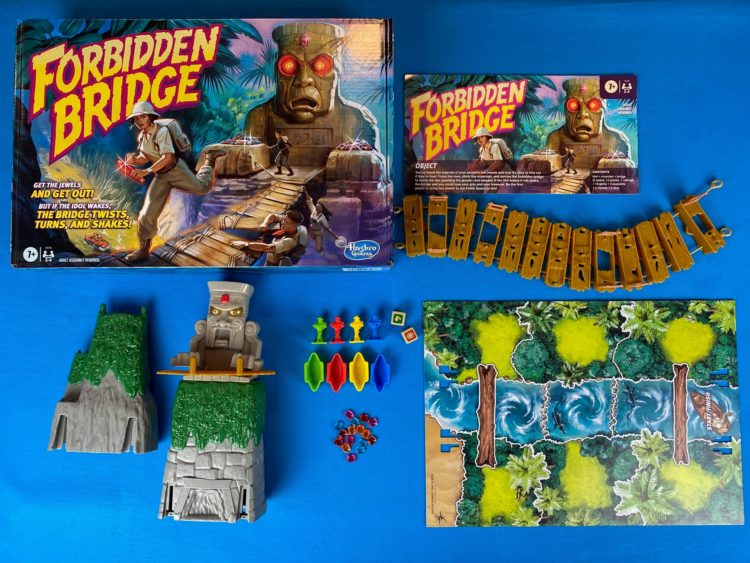
SETUP
The game itself is assembled by attaching the idol and the mountain to the game board. Be sure to place the Idol on the end with the Start and Finish space. Connect the idol and mountain with the bridge by placing the rope loops over the pegs.
Place six jewels in each of the idol’s hands. Players choose the color token they want and also grab the corresponding canoe. Place the explorers in their canoes and then put the canoes on the Start space.
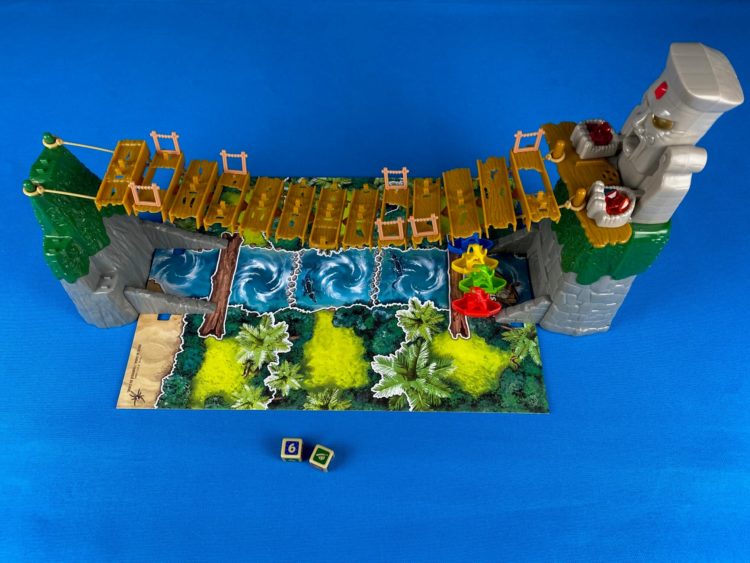
THE PLAY
The youngest player gets to go first. Players are trying to cross the river, climb the cliff, and cross the bridge in order to retrieve jewels and bring them back to their canoes. Along the way, explorer tokens as well as jewels may fall from the bridge. This means that the player who fell or an opponent might retrieve a jewel from a location other than the idol’s hands.
ROLL BOTH DICE
A player begins their turn by rolling both dice.
NUMBER DIE AND MOVEMENT
The number die determines how many spaces a player will move. Including the Start space, there are five river spaces separated by a log or a rock bed. Once a player has landed on the fifth river space by the cliff, the next space is the beach. Players move the canoe to the beach. From there, the explorer moves from the canoe to the cliff.
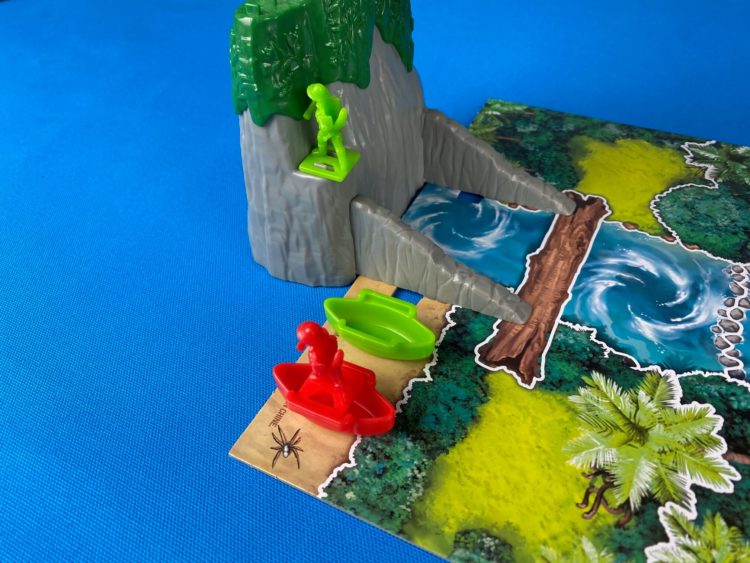
After climbing the cliff, the player moves to the bridge. As a player’s explorer crosses the bridge, there is a good chance they will be tossed off of the bridge by the angry idol. If an explorer simply falls to its side or is left hanging on the bridge, it must use one move from the movement die to stand back up, and then continue its movement from there. If the figure falls from the bridge, it is moved to the closest jungle space and left on its side. On that player’s next turn, one movement is used to stand the explorer up before moving again. If a player falls and lands on the water, it is moved to the closest jungle space.
Once in the jungle, the player must always be moving towards a jewel whether in the idol’s hands, on the bridge, or somewhere on the jungle floor. An explorer cannot move in the water until they have two jewels and are back in their canoe. When crossing from one side of the jungle to the other, the logs and rocks act as a connector, and the player simply hops from one jungle space to the other without stopping.
When on the bridge, only three players may be on a single plank at one time. If a player ever lands on a fully occupied bridge plank at the end of their movement, they simply move one more space ahead. At the end of the bridge is the idol platform. Once on this platform, players can take one jewel from the idol’s hands. Only two explorers can be on the platform at once. A player does not have to roll an exact number in order to land on the platform. If a player approaches the platform, and it is full, that player must wait until there is an open space in order to move onto it.
ACTION DIE
There are three different icons on the action die. When the jewel icon is rolled, the player may steal a jewel from another player that is in the same space. This action may be completed before or after the player moves. A player is not allowed to steal a jewel if their backpack already has a jewel in it. Also, jewels cannot be stolen from canoes.
If the explorer icon is rolled, that player may move one other player’s explorer token that is on the bridge at any time during their turn. The token can be moved to a more dangerous spot on the same plank. The explorer must be placed firmly on the plank, and it cannot be hung from the bridge. If there are no explorers on the bridge, this action does not occur.
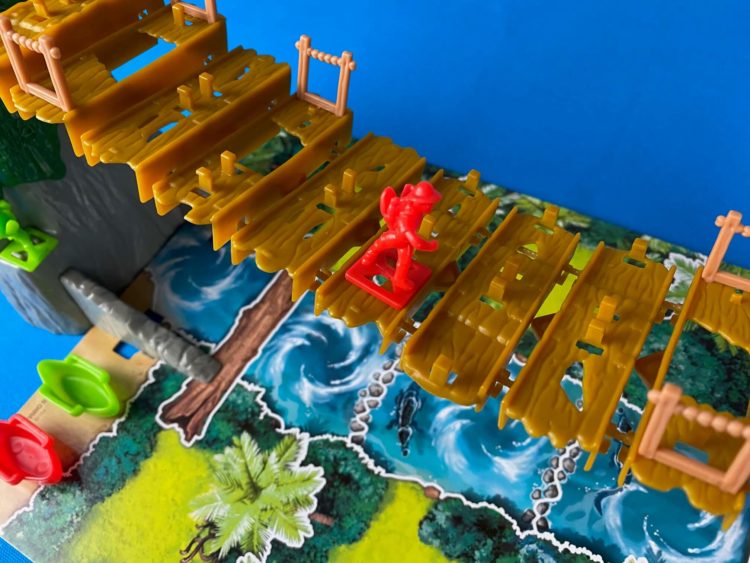
If the idol icon is rolled, that player activates the angry idol to shake the bridge at the beginning of their turn. If there are not any explorers on the bridge, do not complete the action.

JEWELS
When a player reaches the idol’s platform, they may take one jewel from the idol’s hand and place it in their backpack. After doing so, the player must return their explorer to their canoe. Drop the jewel off into the canoe by moving and landing on it or passing through the space. After dropping one jewel off in the canoe, the player will move to retrieve a second jewel from the idol.
It is possible for a player to retrieve a jewel that has been dropped by an opponent. A player may pick up a fallen jewel by either landing on the spot with the jewel or passing by it. Of course, the player’s backpack must be empty in order to pick up the dropped jewel.
If a jewel is dropped and falls into the water, it is placed back in one of the idol’s hands. If the jewel falls on one of the jungle spaces, the jewel stays there until it is retrieved. If the jewel lands on a border such as the log or rocks, it is moved to the nearest jungle space. If the jewel goes off of the board completely, move it to the closest jungle space.
Finally, if a jewel is dropped into a player’s canoe, that player gets to keep it.
WINNING
Play continues as described above until one player returns to the Finish space with two jewels. One jewel must be in the canoe, and one must be in that explorer’s backpack. The first player to do this wins the game.
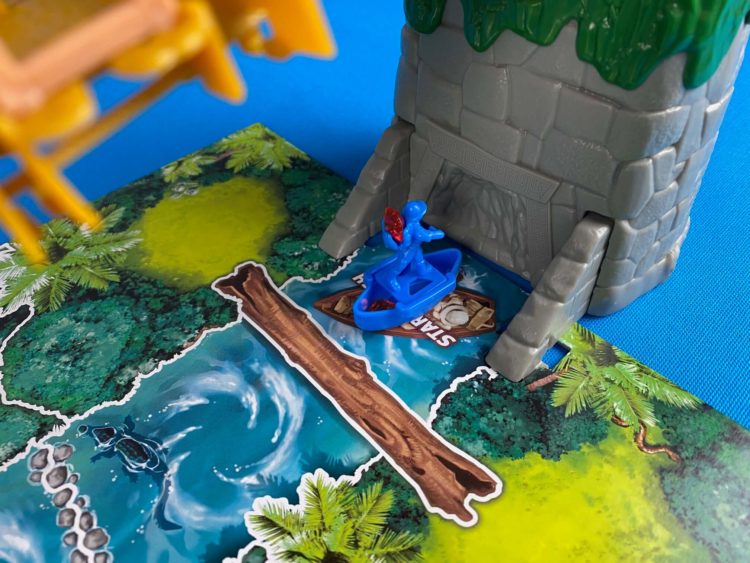
- TRIPLE SNAKES - February 15, 2021